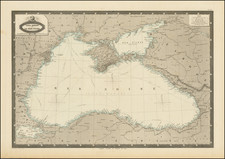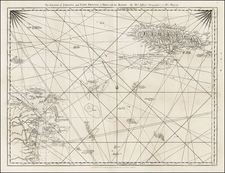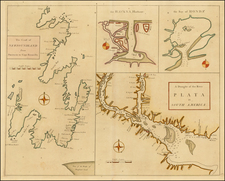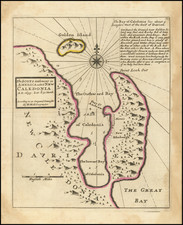"Published under the auspices of the Supreme Government."
Rare early map of El Salvador, published in 1905, based upon work undertaken by Santiago I Barberena and Jose E. Alcaine, between 1892 and 1905. This is apparently the first edition of the map, which was re-issued in 1913. The map was prepare by lithographers Waterlow & Sons in London, for publication in El Salvador.
This is the map referenced by the International Court of Justice in both 1917 and 2000, resolving the dispute between El Salvador and Honduras regarding the littoral waters of the Bay which separates the two countries in the Gulfo de Fonseca.
This rare wall map shows the entire country in remarkable detail. The map was created by Jose E. Alcaine and Santiago I. Barbernay (1851-1916) both of the Universidad de San Salvador.
The map locates cities, towns and villages, roads, trails, mountains and watershed. In the Golfo de Fonseca all islands are detailed including limited soundings.
The decorative title cartouche includes a pre-1912 coat of arms for El Salvador. Its center consists of a triangle with a single volcano rising from the sea. Above the volcano is a Phrygian cap on a staff with a sunburst behind and two large cornucopia below. In 1912 the single volcano was replaced by five volcanoes to symbolize the five member states of the United Provinces of Central America.
The map includes a table of distances between major cities and a table of geographical data.
Includes an inset "Plano de San Salvador", capital city of El Salvador, and 6 lithographic vignettes, illustrating:
- Plaza de Santa Ana y Palacio Municipal
- Palacio de Justicia y Oficina de Correos
- Cuartel de Artilleria
- Palacio de GobiernoUniversidad NacionalTeatro Nacional
Santiago I. Barberena
Santiago Ignacio Barberena Fuentes (1851-1916) was a Salvadoran lawyer, teacher, historian, engineer and linguist. Born in Guatemala to Salvadoran parents, he settled in San Salvador in 1859, where he completed his studies, including a law degree and a topographical engineering degree.
Dr. Berberena worked as a surveyor and astronomer for the Boundary Commission between Guatemala and Mexico (1878-1881). He also examined the north-eastern area of El Salvador, in order to draw a dividing line between the republics of El Salvador and Honduras in 1886.
In the field of archeology , Dr. Barberena, led in 1888, at the invitation of the government of Honduras, an expedition to the Mayan archaeological site of Copán . In 1892, he made the first archaeological explorations in the sites of El Tazumal, Casa Blanca and Cara Sucia in the western zone of El Salvador, as well as in the Cueva del Espíritu Santo, in Corinto, Morazán. He was director of the Astronomical and Meteorological Observatory of El Salvador (1893-1911) and the National Museum of El Salvador (1903-1911), now known by the official name of National Museum of Anthropology Dr. David J. Guzmán.
Dr. Barberena was a founding member of the Academy of Sciences and Fine Arts in San Salvador (1888), and a member of the Salvadoran Academy of Language .













![The West India Islands, and Central America [with] Jamaica](https://storage.googleapis.com/raremaps/img/small/78675.jpg)


